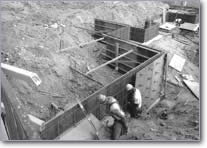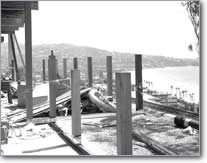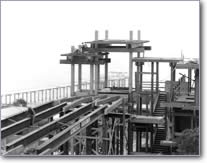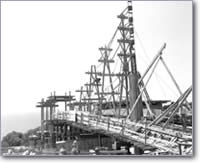1990
 Laying the foundations for the
Laying the foundations for thenew IGPP Revelle Laboratory
George E. Backus elected a foreign member of the French Académie des Sciences. Jean-Bernard Minster elected a Fellow of the American Geophysical Union. Jonathan Berger elected a Fellow of the American Geophysical Union. William Young, PORD/IGPP, received the Macelwane Award, American Geophysical Union. Peter Shearer stacks global seismic data, finding new evidence for a mantle discontinuity at 520-km depth. New IDA stations established in Alert, Canada; Erimo, Japan; Ala-Archa, Kyrgystan; Sutherland, South Africa.
1991
 Support pillars for the Revelle
Support pillars for the RevelleLab Building 3000
Establishment of Scripps Orbit and Permanent Array Center (SOPAC) using GPS satellites to study earthquakes, tectonic plate motion and boundary deformation with Yehuda Bock as Principal Investigator. J. Freeman Gilbert received the 1990 Balzan Prize from the International Balzan Foundation of Milan, Italy. Kyrgyz array established by Frank Vernon in central Asia. IGPP becomes a Core Institution in the NSF S&T Center, the Southern California Earthquake Center or SCEC, with Bernard Minster as the representative to the Board of Directors. Mark Zumberge and others observe the variation of gravity in a submersible to 5-km depth to obtain an accurate measure of the Newtonian gravitational constant. Walter Munk and Andrew Forbes transmit sound to both the east and west coasts of the U.S. from a source suspended below the U.S. Navy vessel M/V Cory Chouest sailing near Heard Island in the southern Indian Ocean - the Heard shot around the world. Yehuda Bock elected a Fellow of the International Association of Geodesy.
1992
 Construction of Revelle Lab
Construction of Revelle LabBuilding 2000
Walter H. Munk awarded the 1992-1993 Presidential Award of the New York Academy of Sciences. Walter H. Munk selected 1992 UCSD Alumnus of the Year. The Permanent GPS Geodetic Array in southern California operated by SOPAC provides the first geodetic determination of coseismic deformation during the June 28 Landers earthquake. Frank Wyatt and Duncan Agnew measure the coseismic and postseismic strain following the Landers earthquake at the Piñon Flat Observatory. Guy Masters and Bob Woodward include ScS phases in global mantle tomography. Establishment of the Acoustic Thermometry of Ocean Climate (ATOC) program to study the effects of global warming with Walter Munk as Principal Investigator. Ute Herzfeld awarded the President's Prize, International Assn. for Mathematical Geology. Bradley Werner awarded the Young Investigator Award, Office of Naval Research. SOPAC becomes a Global Data Center and GPS Orbit Analysis Center for the International GPS Service for Geodynamics (IGS). IGPP records aftershocks of the Landers earthquake on a portable broadband array and develops an archive of all aftershock data for SCEC. New IDA stations established in Lovozero and Norilsk, Russia.
1993
 Construction of Revelle Lab
Construction of Revelle LabBuilding 4000 and the Scripps
Crossing bridge
Walter H. Munk elected a member of the Russian Academy of Sciences. Walter H. Munk received the Presidential Award, New York Academy of Sciences Walter H. Munk awarded the Vetlesen Prize, Columbia University Walter H. Munk received the Scientist of the Year Award, ARCS (Achievement Rewards for College Scientists) Kent, Harding, and Orcutt complete investigation of magma chamber segmentation & upper crustal development along the 9 N segment of the East Pacific Rise. Completion of four new IGPP buildings known as the "IGPP Revelle Laboratory." Turkmenistan Alibek Array established by Frank Vernon. Geophysical Inverse Theory published by Princeton University Press. New IDA stations established in Alibek, Turkmenistan and Flin Flon, Canada.
1994
 Construction of the Scripps
Construction of the ScrippsCrossing bridge
John Orcutt received the 1994 Maurice Ewing Medal from the U.S. Navy and the American Geophysical Union for his outstanding marine science research. J. Freeman Gilbert granted the degree of Doctor honoris causa in Earth Sciences by Utrecht University in the Netherlands. J. Freeman Gilbert elected Socio Straniero (Foreign Member), Accademia Nazionale Dei Lincei, Italy. IGPP records aftershocks of the Northridge earthquake on a portable broadband array and develops an archive of all aftershock data for SCEC. John Miles elected a Fellow of the American Association for the Advancement of Science. The La Jolla branch of the Institute of Geophysics and Planetary Physics, based at Scripps, was renamed in honor of Cecil and Ida Green. Scripps is now the home of the Cecil H. and Ida M. Green Institute of Geophysics and Planetary Physics. The IGPP Systemwide Office moved to La Jolla with Bernard Minster as Systemwide Director. First ocean bottom absolute gravity measurement made by Mark Zumberge. Laser strainmeter measurements are made on the San Andreas by Frank Wyatt, Duncan Agnew, Mark Zumberge, and Hadley Johnson. Constable, Parker and O’Brien contradict assertion that magnetic diffusion in Earth’s core is required by data this century. New IDA stations established in Hobart and Tennant Creek, Australia; Monasavu, Fiji; Borgarnes, Iceland; Borovoye, Kazakhstan; Ascension Island; Nilore, Pakistan
1995
Project IDA (International Deployment of Accelerometers) celebrates its 20th Anniversary in 1995 with 32 stations in 17 countries and projections for nearly 50 stations by 1996. T. Guy Masters elected a Fellow of the American Geophysical Union. Jason Phipps Morgan awarded the Macelwane Medal, American Geophysical Union. First successful towed deep-water gravity survey, Mark Zumberge and Jeff Ridgway. David Sandwell, Walter Smith, John Orcutt and Walter Munk work with Navy to declassify all Geosat altimeter measurements of the Oceans. First seafloor optical fiber strain measurement off the SIO pier. First ATOC sound source 50 miles off Half Moon Bay at Pioneer Seamount begins transmissions. Luciana Astiz, Paul Earle and Peter Shearer make the first three-component global stacks of Global Seismic Network broadband data. New IDA stations established in Kurchatov, Kazakhstan; Las Juntas, Costa Rica; Mahe, Seychelle Islands; St. Helena Island.
1996
George Backus awarded Docteur Honoris Causa at the Sorbonne, Institut de Physique du Globe, Université de Paris IV. Walter H. Munk awarded Honorary Doctor of Philosophy, Schools of Science, University of Crete. Michael Hedlin, Peter Shearer and Paul Earle find strong evidence that small scale elastic heterogeneities are not concentrated in D" but are uniformly distributed throughout the mantle. Yehuda Bock, Jie Zhang and colleagues using PGGA data collected between the Landers and Northridge earthquakes report on a region-wide change in displacement rates after the Landers earthquake. John Orcutt awarded the Secretary of the Navy/Chief of Naval Operations Chair in Oceanography. Bradley Werner appointed the Office of Naval Research/Scripps Institution of Oceanography Scholar The Permanent GPS Geodetic Array is integrated with the Southern California Integrated GPS Network (SCIGN) under the umbrella of the Southern California Earthquake Center. Funding is received from NASA and NSF to expand the array to a size of 120 stations, with an ultimate goal of 250 sites. Richard Salmon named a Fellow of the American Academy of Arts and Sciences. Rick Salmon elected a Fellow of the American Geophysical Union. Steve Constable develops a seafloor magnetotelluric method for use in oil exploration and conducts first 100-site commercial survey in the Mediterranean. Foundations of Geomagnetism published by Cambridge University Press. New IDA stations established in Mount Kent, Falkland Islands; Azores, Portugal; Ar Rayn, Saudi Arabia; South Georgia Island; Cocos Keeling Island 1988. Backus develops rigorous inference scheme for incorporating hard quadratic bounds in geophysical inverse problems. Peter Worcester elected a Fellow of the American Acoustical Society. Parker and Constable propose grand Gaussian process as a model for geomagnetic secular variation. This work essentially revolutionized the study of secular variation and has been the jumping off point for scores of papers in the field. Jonathan Berger and his group establish the first US government funded seismic stations in the USSR at Obninsk, Arti, Kislovodsk, Garm, and Irkutsk as part of IDA network. Additional IDA station established in Nana, Peru.
1997
David Sandwell elected a Fellow of the American Geophysical Union. Cathy Constable receives the Price Medal of the Royal Astronomical Society. John Orcutt receives the 1997 UCSD Alumnus of the Year Award. New IDA station established in Kodiak Alaska. IGPP and Cambridge University conduct the first three-dimensional reflection survey of a mid-ocean ridge (Harding, Kent, Orcutt).
1998
IGPP hosts its 100th Green Scholar, Professor Fredrik Zachariasen. Parker awarded Gold Medal of the Royal Astronomical Society. Guy Masters, Gabi Laske, and Freeman Gilbert measure coupling-splitting matrices for Earth's elastic-gravitational free oscillations with the matrix autoregressive method. Michael Hedlin and John Vidale (UCLA) find evidence for partial melt at the Core-Mantle Boundary.
1999
Walter Munk received the 1999 Kyoto Prize in Basic Science for his lifetime achievements in physical oceanography. Freeman Gilbert received the 1999 Bowie Medal of the American Geophysical Union for his research achievements in global seismology. Professors Cathy Constable and Peter Shearer elected Fellows of the American Geophysical Union. The Puente Hills blind thrust fault beneath Los Angeles was discovered by Peter Shearer and John Shaw. New IDA stations being established in Sulewesi, Indonesia; Kwajalein, Marshall Islands, and Mbarara, Uganda IGPP selected to operate a national seafloor seismology facility for the National Science Foundation.
